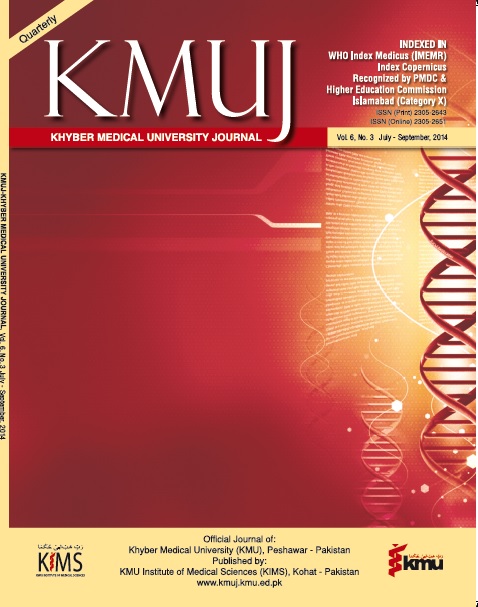OBESITY RELATED MATERNAL COMPLICATIONS IN PREGNANT WOMEN
Main Article Content
Abstract
Objective: To determine the frequency of maternal complications in obese antenatal women.
Methodology: This descriptive cross sectional study was conducted in department of obstetrics and gynecology, Lady Reading hospital, Peshawar-Pakistan, from April 2010 to March 2011. Total 250 consecutive antenatal patients with BMI >25kg/m2 (as per criteria for Asian population) were included in the study that fulfilled the inclusion criteria. Maternal complications associated with obesity like gestational diabetes, pregnancy induced hypertension (PIH), pre-eclampsia, cesarean section and reduced vaginal birth after cesarean section (VBAC) was determined. Data was analyzed by SPSS version 10.
Results: Out of 250 obese antenatal women, 189 (75.6%) were multigravida and 61 (24.4%) were primigravida. In 212 (84.8%) cases, BMI ranged from 26-30 kg/m2 and in 38 (15.2%) cases it was 31-36kg/m2. Majority (n=166; 66.8 %) were ranging in age from 21-30 years and 190 (76%) cases had gestational age of 36–40 weeks. Gestational diabetes (20.4%), pregnancy induced hypertension (17.2%), pre-eclampsia (4.8%), increased, cesarean rate (30.4%), reduced VBAC rates (13.2%) were the common maternal complications in obese antenatal women.
Conclusion: Obesity in pregnancy is associated with adverse maternal outcome like gestational diabetes, pregnancy induced hypertension, pre-eclampsia, increased, cesarean rate and reduced VBAC rates.
Article Details
Work published in KMUJ is licensed under a
Creative Commons Attribution 4.0 License
Authors are permitted and encouraged to post their work online (e.g., in institutional repositories or on their website) prior to and during the submission process, as it can lead to productive exchanges, as well as earlier and greater citation of published work.
(e.g., in institutional repositories or on their website) prior to and during the submission process, as it can lead to productive exchanges, as well as earlier and greater citation of published work.
References
World Health Organization. Global Health Observatory (GHO). Obesity: Situation and trends. Cited on October 23, 2013]. Available from URL: http://www.who.int/gho/ncd/risk_factors/obesity_text/en/
Lingam KMG, Faroohi NG, Greer IA, Sattar N. Changes in booking body mass index over a decade: retrospective analysis from a Glasgow maternity hospital. Br J Obstet Gynacecol 2005;112:1431–3.
World Health Organization, Western Pacific Region. The International Association for the Study of Obesity and the International Obesity Task Force. The Asia–Pacific perspective: redefining obesity and its treatment. Sydney, Australia: Health Communications Australia Pty Limited; 2000. [Cited on December 03, 2013]. Available from URL: www.diabetes.com. au/pdf/obesity_report.pdf
Choo V. WHO reassesses appropriate body- mass index for Asian populations. Lancet 2002; 360: 235.
Nanan OJ. The obesity pandemic implications for Pakistan. J Pak Med Assoc 2002;52:342-6.
Kanagalingam MG, Forouhi NG, Greer lA, Sattar N. Changes in booking body mass index over a decade: retrospective analysis from a Glasgow Maternity Hospital. Br J Obstet Gynecol 2005:112: 1431-3.
Bilal N, Akbar N, Khan AB. Obesity is a gateway to complications. Ann Pak Inst Med Sci 2005;1:230–3.
Linne Y. Effects of obesity on women's reproduction and complications during pregnancy. Obes Rev 2004;5:137-43.
Vyas S, Ghani L, Khazaezadeh N and Oteng - Ntim E. Pregnancy and obesity. In: Studd J, Tan SL, Chervenak FA (editors). Progress in obstetrics and gynecology. China. Elsevier Publishers; 2008:11-28.
Vahratian A, Siega-Riz AM, Savitz OA, Zhang I. Maternal pre-pregnancy overweight and obesity and the risk of caesarean delivery in nulliparous women . Ann Epidemiol 2005:15467-74.
Sheiner E, Levy A, Menes TS, Silverberg D, Katz M, Mazor M. Maternal obesity as an independent risk factor for caesarean delivery. Paediatr Perinat Epidemiol 2004;18:1- 20%
Castro LC, Avina RL. Maternal obesity and pregnancy out comes. Curr Opin Obstet Gynecol 2002;14:601-6.
de Groot LC. High maternal body weight and pregnancy outcome. Nutr Rev 199;57: 62-4.
Jaleel R. Impact of maternal obesity on pregnancy outcome. J Surg Pak 2009;14:2–6.
Ali HS, Lakhani N. Effect of obesity and its outcome among pregnant women. Pak J Med Sci 2011;27(5):1126-8.
Shabab U, Tahir S. Effect of obesity on cesarean Section rate. J Surg Pak (Internat) 2010;15 (2):92-6.
Sebire NJ, Jolly M, Harris JP, Joffe M, Regan L et al. Maternal obesity and pregnancy out come . Internat J Obesity 2001;25:1175-82.
Callaway LK, Prins JB, Chang AM, McIntyre HD. The prevalence and impact of overweight and obesity in an Australian obstetric population. Med J Australia 2006;184: 56-9.
Arendas K, Qin Q, Gruslin A. Obesity in pregnancy: pre-conceptional to postpartum consequences. J Obstet Gyaenecol Can 2008;30:477-88.
Gartier F, Raingeard I, Renard E, Boulot P, Bringer J. Optimizing the outcome of pregnancy in obese women: from pregestational to long term management. Diabetes Metab 2008;34:19-25.
Abenhaim HA, Kinch RA, Morin L, Benjamin A, Usher R. Effect of pre pregnancy body mass index categories on obstetrical and neonatal outcomes. Arch Gynecol Obstet 2007;275:39-43.
Chauhan SP, Magann DR, Carroll CS, Barrilleaux PS, Scardo JA, Martin Jr JN. Mode of delivery for morbidly obese with prior cesarean delivery. Vaginal versus repeat cesarean section. Am J Obstet Gynecol. 2007;185: 349 –54 .
